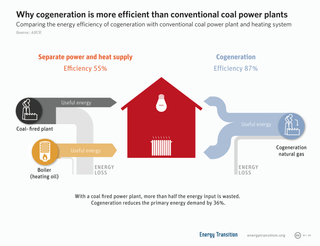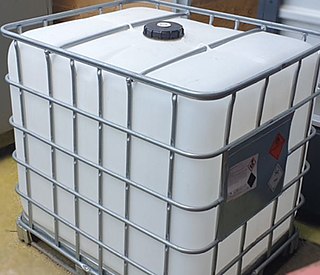Denmark's first full-scale wind-Hydrogen energy plant and testing facility, the Lolland Hydrogen Community, began operation in May 2007. [1] It is also the European Union's first full-scale Hydrogen Community Demonstration facility for residential Fuel Cell Combined Heat and Power (CHP). [2]
Phase 3 of the project that ran until 2012 and was the installing of fuel cell micro combined heat and power plants. [3]
Located in the city of Nakskov on the island of Lolland, where wind power is abundant, the hydrogen energy plant was received with funding from the Danish Energy Authority, which is a joint partnership between the Municipality of Lolland, IRD Fuel Cells, and Baltic Sea Solutions.
The island of Lolland is producing 50% more energy from renewable energy sources than it consumes, and the hydrogen project was seeking to locally store excess wind power in the form of hydrogen, for use in residential and industrial facilities. [2]
Hydrogen is produced by using excess wind power to electrolyze water to produce hydrogen and oxygen. The oxygen is used in the municipal water treatment plant nearby to speed up the biological process. The hydrogen is stored in low-pressure storage tanks at six bars and fuels two PEM Fuel Cell Micro Combined Heat and Power (CHP) stations of 2 kilowatts (kW) and 6.5 kW, respectively. [2]

A fuel cell is an electrochemical cell that converts the chemical energy of a fuel and an oxidizing agent into electricity through a pair of redox reactions. Fuel cells are different from most batteries in requiring a continuous source of fuel and oxygen to sustain the chemical reaction, whereas in a battery the chemical energy usually comes from substances that are already present in the battery. Fuel cells can produce electricity continuously for as long as fuel and oxygen are supplied.

Energy storage is the capture of energy produced at one time for use at a later time to reduce imbalances between energy demand and energy production. A device that stores energy is generally called an accumulator or battery. Energy comes in multiple forms including radiation, chemical, gravitational potential, electrical potential, electricity, elevated temperature, latent heat and kinetic. Energy storage involves converting energy from forms that are difficult to store to more conveniently or economically storable forms.
Distributed generation, also distributed energy, on-site generation (OSG), or district/decentralized energy, is electrical generation and storage performed by a variety of small, grid-connected or distribution system-connected devices referred to as distributed energy resources (DER).

Gasification is a process that converts biomass- or fossil fuel-based carbonaceous materials into gases, including as the largest fractions: nitrogen (N2), carbon monoxide (CO), hydrogen (H2), and carbon dioxide (CO2). This is achieved by reacting the feedstock material at high temperatures (typically >700 °C), without combustion, via controlling the amount of oxygen and/or steam present in the reaction. The resulting gas mixture is called syngas (from synthesis gas) or producer gas and is itself a fuel due to the flammability of the H2 and CO of which the gas is largely composed. Power can be derived from the subsequent combustion of the resultant gas, and is considered to be a source of renewable energy if the gasified compounds were obtained from biomass feedstock.

Cogeneration or combined heat and power (CHP) is the use of a heat engine or power station to generate electricity and useful heat at the same time.
The hydrogen economy is using hydrogen to decarbonize economic sectors which are hard to electrify, essentially, the "hard-to-abate" sectors such as cement, steel, long-haul transport etc. In order to phase out fossil fuels and limit climate change, hydrogen can be created from water using renewable sources such as wind and solar, and its combustion only releases water vapor to the atmosphere.
Hydrogen fuel is a zero-carbon fuel burned with oxygen; provided that it is created in a process that does not involve carbon. It can be used in fuel cells or internal combustion engines. Regarding hydrogen vehicles, hydrogen has begun to be used in commercial fuel cell vehicles such as passenger cars, and has been used in fuel cell buses for many years. It is also used as a fuel for spacecraft propulsion.

Grid energy storage is a collection of methods used for energy storage on a large scale within an electrical power grid. Electrical energy is stored during times when electricity is plentiful and inexpensive or when demand is low, and later returned to the grid when demand is high, and electricity prices tend to be higher.

District heating is a system for distributing heat generated in a centralized location through a system of insulated pipes for residential and commercial heating requirements such as space heating and water heating. The heat is often obtained from a cogeneration plant burning fossil fuels or biomass, but heat-only boiler stations, geothermal heating, heat pumps and central solar heating are also used, as well as heat waste from factories and nuclear power electricity generation. District heating plants can provide higher efficiencies and better pollution control than localized boilers. According to some research, district heating with combined heat and power (CHPDH) is the cheapest method of cutting carbon emissions, and has one of the lowest carbon footprints of all fossil generation plants.

The methanol economy is a suggested future economy in which methanol and dimethyl ether replace fossil fuels as a means of energy storage, ground transportation fuel, and raw material for synthetic hydrocarbons and their products. It offers an alternative to the proposed hydrogen economy or ethanol economy, though these concepts are not exclusive.
Micro combined heat and power, micro-CHP, µCHP or mCHP is an extension of the idea of cogeneration to the single/multi family home or small office building in the range of up to 50 kW. Usual technologies for the production of heat and power in one common process are e.g. internal combustion engines, micro gas turbines, stirling engines or fuel cells.

Microgeneration is the small-scale generation of heat and electric power by individuals, small businesses and communities to meet their own needs, as alternatives or supplements to traditional centralized grid-connected power. Although this may be motivated by practical considerations, such as unreliable grid power or long distance from the electrical grid, the term is mainly used currently for environmentally-conscious approaches that aspire to zero or low-carbon footprints or cost reduction. It differs from micropower in that it is principally concerned with fixed power plants rather than for use with mobile devices.

Hybrid power are combinations between different technologies to produce power.

Iceland is a world leader in renewable energy. 100% of Iceland's electricity grid is produced from renewable resources. In terms of total energy supply, 85% of the total primary energy supply in Iceland is derived from domestically produced renewable energy sources. Geothermal energy provided about 65% of primary energy in 2016, the share of hydropower was 20%, and the share of fossil fuels was 15%.
A grid-tied electrical system, also called tied to grid or grid tie system, is a semi-autonomous electrical generation or grid energy storage system which links to the mains to feed excess capacity back to the local mains electrical grid. When insufficient electricity is available, electricity drawn from the mains grid can make up the shortfall. Conversely when excess electricity is available, it is sent to the main grid. When the Utility or network operator restricts the amount of energy that goes into the grid, it is possible to prevent any input into the grid by installing Export Limiting devices.
Energy recycling is the energy recovery process of utilizing energy that would normally be wasted, usually by converting it into electricity or thermal energy. Undertaken at manufacturing facilities, power plants, and large institutions such as hospitals and universities, it significantly increases efficiency, thereby reducing energy costs and greenhouse gas pollution simultaneously. The process is noted for its potential to mitigate global warming profitably. This work is usually done in the form of combined heat and power or waste heat recovery.
A home fuel cell or a residential fuel cell is an electrochemical cell used for primary or backup power generation. They are similar to the larger industrial stationary fuel cells, but built on a smaller scale for residential use. These fuel cells are usually based on combined heat and power (CHP) or micro combined heat and power (Micro-CHP) technology, generating both power and heated water or air.
Power-to-gas is a technology that uses electric power to produce a gaseous fuel. When using surplus power from wind generation, the concept is sometimes called windgas.
Hydrogenics is a developer and manufacturer of hydrogen generation and fuel cell products based on water electrolysis and proton exchange membrane (PEM) technology. Hydrogenics is divided into two business units: OnSite Generation and Power Systems. Onsite Generation is headquartered in Oevel, Belgium and had 73 full-time employees as of December 2013. Power Systems is based in Mississauga, Ontario, Canada, with a satellite facility in Gladbeck, Germany. It had 62 full-time employees as of December 2013. Hydrogenics maintains operations in Belgium, Canada and Germany with satellite offices in the United States, Indonesia, Malaysia and Russia.
Denmark is a leading country in wind energy production and wind turbine production. Wind power alone produced 47% of Denmark's electricity consumption in 2017, and is expected to increase its production by nearly 80% in the years to 2024.
Coordinates: 54°50′N11°09′E / 54.833°N 11.150°E